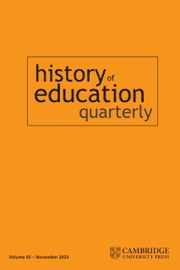The United States Department of Education (USDOE) represents a quintessential “horizontal institution” in American higher education. Unlike the vertical magnificence of a college campus whose bell towers, monuments, and memorials soar upward, the USDOE can be compared to a paper trail. Its numerous databases available in the public domain leave footprints at ground level that cut across the landscape of American higher education. In sum, the USDOE provides invaluable research resources about what has come to be known as postsecondary education. It is low-profile and at the same time essential, and probably underappreciated.
The historical significance is that in 1980 the new US Department of Education brought these databases to life. The timing was fortuitous, because American colleges and universities were mired in what Berkeley economist Earl Cheit had called in 1971 “The New Depression in Higher Education.”Footnote 1 For example, even an established university such as Yale was surprised to discover in 1972 that it had an annual deficit estimated at $1 million.Footnote 2 Numerous colleges were at financial risk due to “stagflation.” By the early 1980s, thanks in part to the USDOE’s role in gathering and publishing databases, colleges and universities became part of a “managerial revolution” of informed decision-making, expedited by improvements in computers and software that allowed for interactive data analyses.
An irony was that colleges’ financial shortfalls between 1971 and 1981 occurred as American higher education was entering an era of student consumerism. Federal student aid, such as that provided as Pell Grants and loans via the Middle Income Student Assistance Act of 1978, was “portable”—which meant that a recipient student could apply the aid to tuition payments at the college of her or his choice. Also, demographic data signaled that the number of high school graduates nationwide was declining. This transformed college admissions from a low-octane endeavor into active recruitment of qualified students who also had been awarded federal aid.
The USDOE sponsored IPEDS—“Integrated Postsecondary Education Data Systems”—and the National Center for Higher Education Management Surveys and the National Institute of Education. Their professional research teams undertook an important role that any college or university could not likely fulfill on its own: they gathered comprehensive data that made comparative surveys and studies possible.
Nationwide data collection opened the door to analyses of “going to college in America.” It helped distinguish the COA (cost of college) from the POA (the price of attendance)—acronyms which became increasingly useful to campus officials, state legislators, and members of Congress, as well as to parents of students applying to college. It led to interesting policy discussions about affordability and the “college tuition gap.” These carried out the kinds of thoughtful policy analyses Chester E. Finn Jr. had introduced in his 1978 book, Scholars, Dollars, and Bureaucrats.Footnote 3
The USDOE did not “make” national policy for higher education. Rather, through its databases it made policy analyses possible. It did so in a nonpartisan fashion, with spirited discussions among congressional staffers and representatives from the “One DuPont Circle” of such higher education associations as the AAU, AAUP, ACE, and NAICU—that is, the Association of American Universities, American Association of University Professors, American Council on Education, and National Association of Independent Colleges and Universities. These information sources also fueled an American obsession with “benchmarking” and academic ratings and rankings, as indicated by the popularity of the U.S. News & World Report’s annual ranking among college applicants as well as prestige-minded college and university officials.
Why did this matter for historians of education? The databases also were useful for studying institutional performance from past to present. So, if someone asked, “Why does college cost so much today?,” historians of education could attempt to figure out when, if ever, college was reasonably affordable for American families. One might follow the money and ask, for example, “Why did college cost so little in 1910?” The answers were not obvious, but the inquiry and comparisons over time were crucial.
One significant use for the databases’ longitudinal perspective was in understanding American college students. Obvious metrics for determining student performance included student retention, attrition, and degree completion. A second use was having systematic data on the composition of entering classes disaggregated by family income, gender, race, and ethnicity. Such historical analyses abetted the present-minded tendency of members of Congress and some other groups to assume that American higher education was in decline.
One inference was that in our move toward mass higher education, we as a nation had drifted from a real or imagined golden age when the majority of colleges once enrolled well-qualified students, had high graduation rates, and enjoyed balanced budgets.Footnote 4 For example, one presumption was that in the early 20th century, “going to college” was prestigious and special. However, what happens when one discovers in a Yale yearbook that the Class of 1903 competed vigorously against the Class of 1904 for the distinction of having the lower graduation rate? As one member of the Class of 1903 boasted:
Never since the Heavenly Host
With All the Titans Fought
Found They a Class Whose Scholarship
Approached so close to Naught!
This student verse raises important questions for historians: What were the student dropout and degree completion rates in earlier eras? Were they different than the rates today? Extending the contemporary databases back in time reveals a complex, interesting story. Historians of education are well suited to integrate statistical data with documentary and archival materials, which allows us to explore whether American undergraduate education was characterized by a “tradition of attrition.”Footnote 5 And, today, it leaves researchers with the question, “Will the dissolution of the US Department of Education leave us without a fertile, useful source of systematic data to undergird serious analysis of higher education?”

